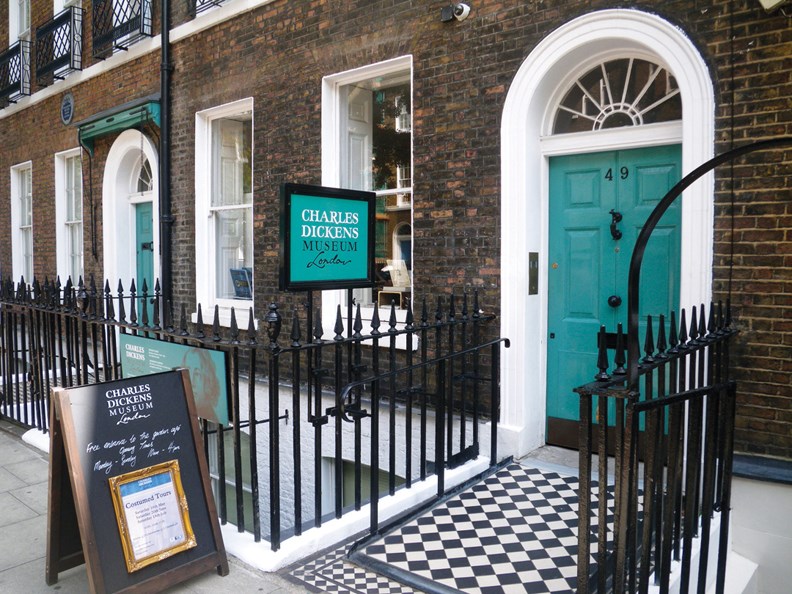A London walking tour and later visit to Charles Dickens’ first home help us learn about the background of his early tales.
Initially, our guide Tom takes us to London’s Victorian-style Guildhall, the setting for Pickwick and Bardell’s trial in Pickwick Papers, Dickens’ first successful novel. Passing St. Bartholomew’s Hospital, we’re told how Jack Hopkins, another Pickwickian, attended an accident victim at a ward. Through a Tudor gateway into a peaceful churchyard, he continues, “Hopkins came here afterwards to contemplate. Untouched by the Great Fire, St. Bart’s fell into disrepair; the cloisters became stables. The 12th century Gothic church was restored during Dickens’ time, yet its parish remained the seedy, model setting for criminals Fagin and Sikes in Oliver Twist.” In an alleyway across the street, there’s the small barred “child-proof” window mentioned in this tale.
The site of London’s oldest meat market lies nearby. “Inscribed on a butcher’s wagon, ‘Pickwick’ inspired Dickens’ title for Pickwick Papers,” Tom says. “In Oliver Twist, he describes Smithfield Market as “nearly ankle deep with filth and mire … a thick steam perpetually rising from the reeking bodies of the cattle … unwashed, unshaven, squalid, and dirty figures constantly running to and fro’.” Now clean and tidy, a placard recounts such Victorian era practices as auctioning wives. Dickens lived a 20-minute walk from this neighbourhood in a three-storey Georgian terrace house.
Another day, we investigate his home, now the Dickens Museum. His great-great-grandson Mark narrates the audio-guide, starting with the foyer’s framed letters. One regards this home’s 1837-1839 lease. Another describes subsequent homes in Marylebone, Tavistock and Gad’s Hill. Many of their displayed furnishings highlight his later life.
Portraits of 25-year-old Dickens and wife Catherine adorn dining room walls. The table is set for fellow literary luminaries and friends. Mark tells us how this cozy room regularly accommodated up to 14 guests. The Dickens obviously loved to entertain.
The opposite morning room displays Dickens’ gossipy, humourous letters to Catherine, illustrating their playful romance. Mark recounts, “They wed in 1836. Paintings show two winsome daughters, who were born here.”
The basement encompasses the kitchen, scullery and washhouse. “Interested in all classes, Dickens often depicted his own servants in his stories,” Mark explains. “And that copper tub appeared in A Christmas Carol. Such tubs were used for boiling laundry, bathing, and making steamed puddings!”
On our way upstairs, we notice a wall image of Dickens racing upward. He was a notably energetic and amazingly prolific writer. The study’s bookcase contains his 15 novels, volumes of short stories and articles. A portrait above his desk reveals a middle-aged Dickens. Our favourite depicts him dreaming up his popular characters.
In the drawing room, we visualize Catherine playing her piano and Dickens presenting dramatic readings to entertain guests. Dickens’ self-designed lectern, used during his popular worldwide performances, stands by the doorway.
His dressing room off the third floor bedroom was a typical middle class convenience. We hear that after fathering ten children, Dickens felt increasingly burdened by family life. Becoming infatuated with a younger woman, he separated from Catherine in 1858.
Besides wooden toys and nightshirts, the attic nursery exhibits bars from London’s Marshalsea Prison, where Dickens’ father was imprisoned as a debtor. Losing his father’s support at age nine, Dickens was forced to work in a blacking factory and attend a second-rate school. Such early experiences fueled his writing on social injustice. Oliver Twist reflects details of his challenging life. And Marshalsea Prison resurfaces in both David Copperfield and Little Dorrit.
Inspired by personal struggles and empathy for others, Charles Dickens created wondrous tales. Our discoveries about his life encourage further reading of his works.



